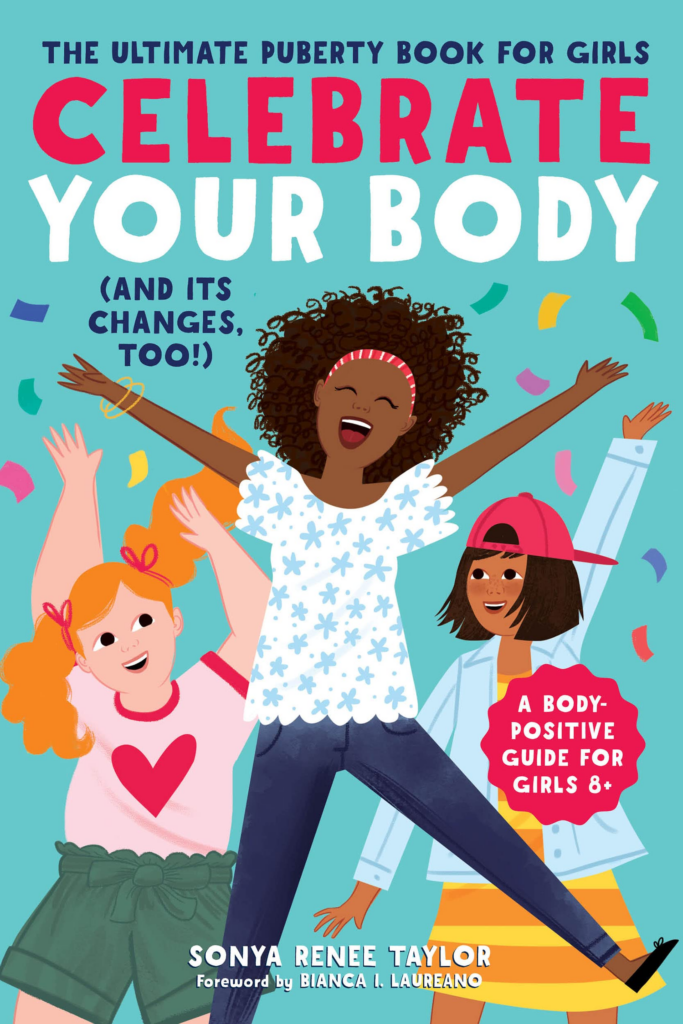When my daughter was handed to me for the first time, I became aware of a few things:
I was overwhelmed with love.
I’d probably never sleep well again.
And I did not want to raise her to live within societal expectations meant to silence her or force her to abide by beauty standards created to constrict.
We have evolved over the years (as we all should; yay for growth!), yet something we’ve never let go of is seeking out feminist-forward representation in media that aligns with our values.
For the last few years, now that my daughter is closer to being a teenager, we’ve had more discussions centered around puberty. Having access to resources and media that depict a diversity of experiences for young girls has created so many opportunities for us to talk. As an adult, this means I’ve also been able to come to terms with what information I did and didn’t have when I was growing up. The lack of resources available to my parents during my adolescent years limited the discussions in our home. At school, it wasn’t much different. Puberty and sex ed resources were not prioritized. Having the ability to choose from and offer updated materials my children can learn from has been healing for me.
Conversations with our kids about body changes, emotions, and relationships are crucial, especially at this point in time when resources for growing kids have been banned in places like Texas and Florida.
As of late, the following movie and book series have been our favorites to analyze as we further explore the topic of puberty and girlhood.
Turning Red (February 2022)
Turning Red is a beautiful coming-of-age animated film recently released by Pixar. The storyline follows Meilin Lee, a 13-year-old Chinese-Canadian girl obsessed with her best friends and 4-Town. Set 20 years ago in 2002, boy bands are uber popular, everyone has a Tamagotchi in their pocket, and kids don’t have their own cell phones yet. The masterminds behind the film (Domee Shi & Julia Cho) have expressed that the setting and characters are based on them and their experiences growing up.
The film expertly depicts girlhood in all its messy and joyous glory. Meilin struggles to balance meeting her parents’ expectations of her while living the way she wants. The pressure becomes so great that she explodes, literally, into a giant red panda. In the film, the panda represents puberty and all the big emotions that come with it. It is also representative of the natural self that Meilin is being instructed to stifle throughout the movie. She comes to terms with that in her own way, with the help of her mother and the women of her family.
This movie centers on puberty and girls’ feelings. It also focuses on mother-daughter relationships, cultural expectations, and being yourself. I think it is a great starting point for subtly launching conversations with older children, especially girls, about growing up. For us, the conversation started like a regular movie review, a typical topic in our home of cinephiles, and dove into a deeper realm. It helped us make a new connection that will always be there, especially when we go back for an inevitable rewatch.
Celebrate Your Body Book Series

Be sure to file Celebrate Your Body (and Its Changes, Too!) by Sonya Renee Taylor and Celebrate Your Body 2: The Ultimate Puberty Book for Preteen and Teen Girls by Dr. Lisa Klein and Dr. Carrie Leff under essential reading. Also file them under: Books I Wish I Had When I Was Younger. The series covers all aspects of puberty, including menstruation, comprehensive sex education (a topic you should definitely turn to fellow contributor Steph Auteri for!), and the adolescent brain. The language is inclusive, the art is so cute, and the concepts are broken down to make the information easily accessible for readers.
These books are jam-packed with super important and scientifically accurate information. The tone of both books is approachable and inviting. It is clear they were created to be a safe space for learning and sparking questions, without any of the shame we may associate with talking about puberty. Something I especially love about these books are the extensive resources included at the end for both young readers and adults. These include books, websites, hotlines, and apps. We love a resource list!
We first picked the second book up a few years ago when my daughter was a little younger, so we didn’t read through all the topics together. However, I’m planning to buy copies of both to have in our family library for a revisit.
For More on this Topic:
Guerrilla Sex Ed (website)
The Period Comic: A Girl’s Easy Guide to Puberty and Periods (book)
The Puberty Prof (podcast)

